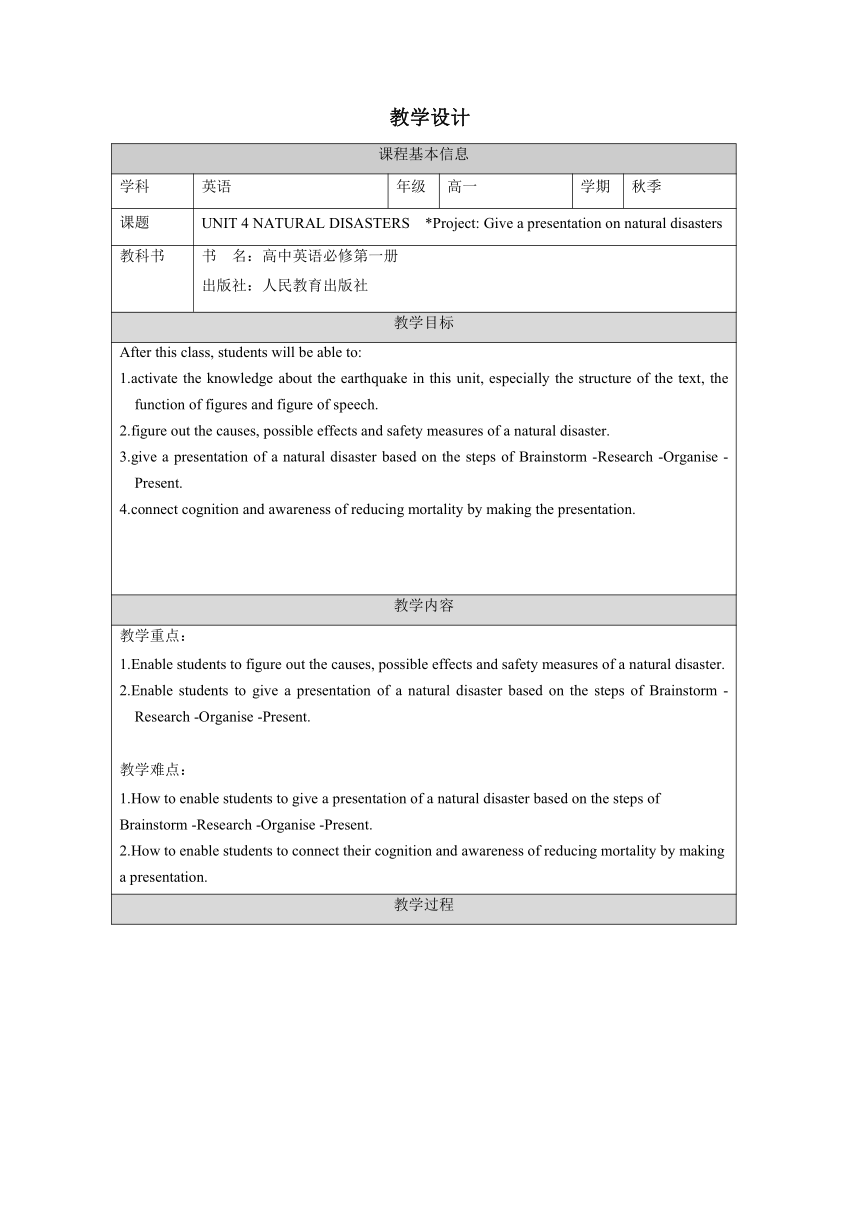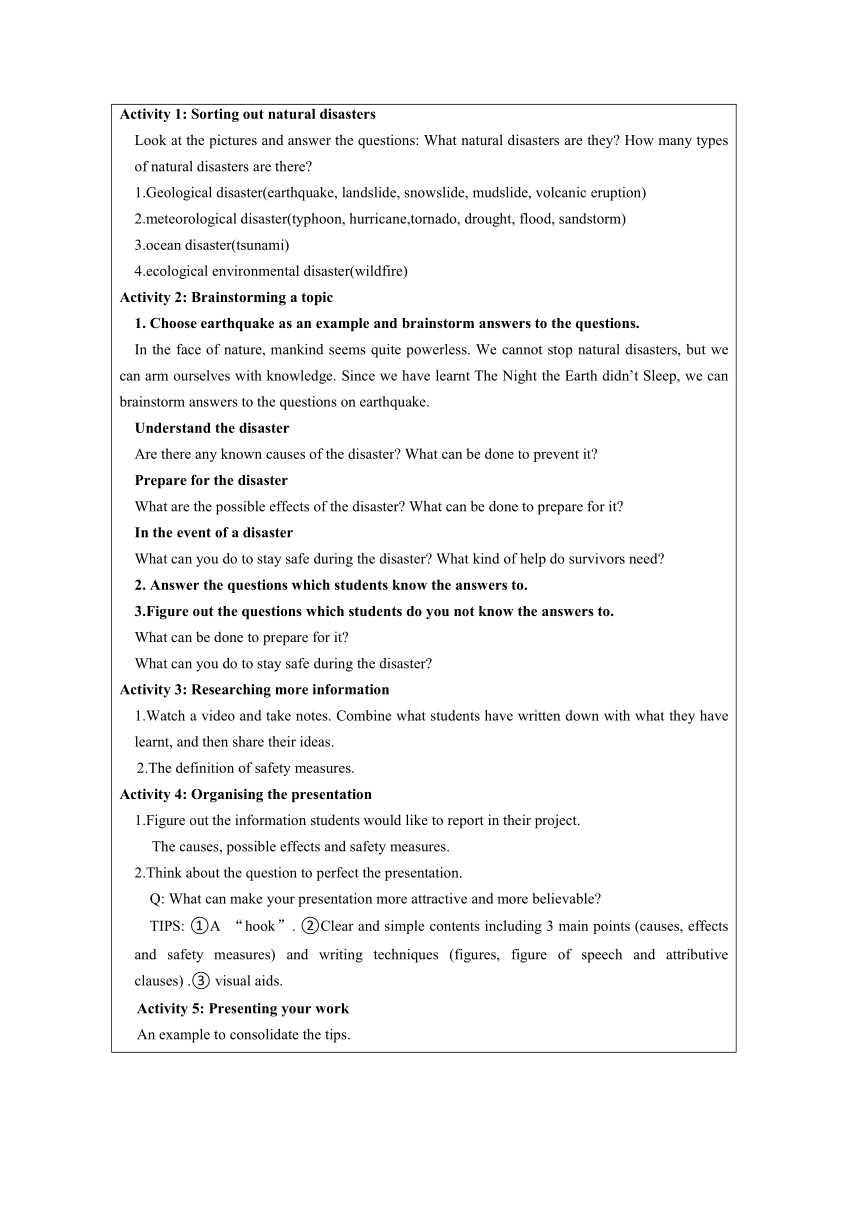人教版(2019)必修第一册Unit4 Natural DisastersProject 教学设计(表格式)
文档属性
| 名称 | 人教版(2019)必修第一册Unit4 Natural DisastersProject 教学设计(表格式) |

|
|
| 格式 | docx | ||
| 文件大小 | 404.9KB | ||
| 资源类型 | 教案 | ||
| 版本资源 | 人教版(2019) | ||
| 科目 | 英语 | ||
| 更新时间 | 2024-04-10 12:23:45 | ||
图片预览


文档简介
教学设计
课程基本信息
学科 英语 年级 高一 学期 秋季
课题 UNIT 4 NATURAL DISASTERS *Project: Give a presentation on natural disasters
教科书 书 名:高中英语必修第一册 出版社:人民教育出版社
教学目标
After this class, students will be able to: 1.activate the knowledge about the earthquake in this unit, especially the structure of the text, the function of figures and figure of speech. 2.figure out the causes, possible effects and safety measures of a natural disaster. 3.give a presentation of a natural disaster based on the steps of Brainstorm -Research -Organise -Present. 4.connect cognition and awareness of reducing mortality by making the presentation.
教学内容
教学重点: 1.Enable students to figure out the causes, possible effects and safety measures of a natural disaster. 2.Enable students to give a presentation of a natural disaster based on the steps of Brainstorm -Research -Organise -Present. 教学难点: 1.How to enable students to give a presentation of a natural disaster based on the steps of Brainstorm -Research -Organise -Present. 2.How to enable students to connect their cognition and awareness of reducing mortality by making a presentation.
教学过程
Activity 1: Sorting out natural disasters Look at the pictures and answer the questions: What natural disasters are they How many types of natural disasters are there 1.Geological disaster(earthquake, landslide, snowslide, mudslide, volcanic eruption) 2.meteorological disaster(typhoon, hurricane,tornado, drought, flood, sandstorm) 3.ocean disaster(tsunami) 4.ecological environmental disaster(wildfire) Activity 2: Brainstorming a topic Choose earthquake as an example and brainstorm answers to the questions. In the face of nature, mankind seems quite powerless. We cannot stop natural disasters, but we can arm ourselves with knowledge. Since we have learnt The Night the Earth didn’t Sleep, we can brainstorm answers to the questions on earthquake. Understand the disaster Are there any known causes of the disaster What can be done to prevent it Prepare for the disaster What are the possible effects of the disaster What can be done to prepare for it In the event of a disaster What can you do to stay safe during the disaster What kind of help do survivors need Answer the questions which students know the answers to. 3.Figure out the questions which students do you not know the answers to. What can be done to prepare for it What can you do to stay safe during the disaster Activity 3: Researching more information 1.Watch a video and take bine what students have written down with what they have learnt, and then share their ideas. 2.The definition of safety measures. Activity 4: Organising the presentation 1.Figure out the information students would like to report in their project. The causes, possible effects and safety measures. 2.Think about the question to perfect the presentation. Q: What can make your presentation more attractive and more believable TIPS: ①A “hook”. ②Clear and simple contents including 3 main points (causes, effects and safety measures) and writing techniques (figures, figure of speech and attributive clauses) .③ visual aids. Activity 5: Presenting your work An example to consolidate the tips. Activity 6: Having a try 1.Focus on one of the natural disasters. Brainstorm the causes, effects and safety measures, research the unknown, organise the information and present it. 2.Appreciate one group’s work. 3.Assess the presentation by following the steps below. NumbersItemsScore1Start with a hook(20 points) (vivid)2Use clear and logical contents (20 points) (logical)3Use visual aids(20 points) (impressive)4Use proper writing techniques(20 points) (objective& clear )5Show good presentation skills(20 points) (wonderful)Total score:
Assignment: 1.Gather more information through some websites/searching engines, some apps, professional books, etc. and then discuss with your group and beautify your work to perfect it. 2.Make a poster or an announcement as you like to present your work. Conclusion In this class, we have: 1.known the basic steps of give a presentation: brainstorm, research, organise and present. 2.crafted and given a presentation based on one natural disaster by using a “hook”, clear and simple contents and visual aids.
备注:教学设计应至少含教学目标、教学内容、教学过程等三个部分,如有其它内容,可自行补充增加。
课程基本信息
学科 英语 年级 高一 学期 秋季
课题 UNIT 4 NATURAL DISASTERS *Project: Give a presentation on natural disasters
教科书 书 名:高中英语必修第一册 出版社:人民教育出版社
教学目标
After this class, students will be able to: 1.activate the knowledge about the earthquake in this unit, especially the structure of the text, the function of figures and figure of speech. 2.figure out the causes, possible effects and safety measures of a natural disaster. 3.give a presentation of a natural disaster based on the steps of Brainstorm -Research -Organise -Present. 4.connect cognition and awareness of reducing mortality by making the presentation.
教学内容
教学重点: 1.Enable students to figure out the causes, possible effects and safety measures of a natural disaster. 2.Enable students to give a presentation of a natural disaster based on the steps of Brainstorm -Research -Organise -Present. 教学难点: 1.How to enable students to give a presentation of a natural disaster based on the steps of Brainstorm -Research -Organise -Present. 2.How to enable students to connect their cognition and awareness of reducing mortality by making a presentation.
教学过程
Activity 1: Sorting out natural disasters Look at the pictures and answer the questions: What natural disasters are they How many types of natural disasters are there 1.Geological disaster(earthquake, landslide, snowslide, mudslide, volcanic eruption) 2.meteorological disaster(typhoon, hurricane,tornado, drought, flood, sandstorm) 3.ocean disaster(tsunami) 4.ecological environmental disaster(wildfire) Activity 2: Brainstorming a topic Choose earthquake as an example and brainstorm answers to the questions. In the face of nature, mankind seems quite powerless. We cannot stop natural disasters, but we can arm ourselves with knowledge. Since we have learnt The Night the Earth didn’t Sleep, we can brainstorm answers to the questions on earthquake. Understand the disaster Are there any known causes of the disaster What can be done to prevent it Prepare for the disaster What are the possible effects of the disaster What can be done to prepare for it In the event of a disaster What can you do to stay safe during the disaster What kind of help do survivors need Answer the questions which students know the answers to. 3.Figure out the questions which students do you not know the answers to. What can be done to prepare for it What can you do to stay safe during the disaster Activity 3: Researching more information 1.Watch a video and take bine what students have written down with what they have learnt, and then share their ideas. 2.The definition of safety measures. Activity 4: Organising the presentation 1.Figure out the information students would like to report in their project. The causes, possible effects and safety measures. 2.Think about the question to perfect the presentation. Q: What can make your presentation more attractive and more believable TIPS: ①A “hook”. ②Clear and simple contents including 3 main points (causes, effects and safety measures) and writing techniques (figures, figure of speech and attributive clauses) .③ visual aids. Activity 5: Presenting your work An example to consolidate the tips. Activity 6: Having a try 1.Focus on one of the natural disasters. Brainstorm the causes, effects and safety measures, research the unknown, organise the information and present it. 2.Appreciate one group’s work. 3.Assess the presentation by following the steps below. NumbersItemsScore1Start with a hook(20 points) (vivid)2Use clear and logical contents (20 points) (logical)3Use visual aids(20 points) (impressive)4Use proper writing techniques(20 points) (objective& clear )5Show good presentation skills(20 points) (wonderful)Total score:
Assignment: 1.Gather more information through some websites/searching engines, some apps, professional books, etc. and then discuss with your group and beautify your work to perfect it. 2.Make a poster or an announcement as you like to present your work. Conclusion In this class, we have: 1.known the basic steps of give a presentation: brainstorm, research, organise and present. 2.crafted and given a presentation based on one natural disaster by using a “hook”, clear and simple contents and visual aids.
备注:教学设计应至少含教学目标、教学内容、教学过程等三个部分,如有其它内容,可自行补充增加。
